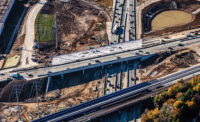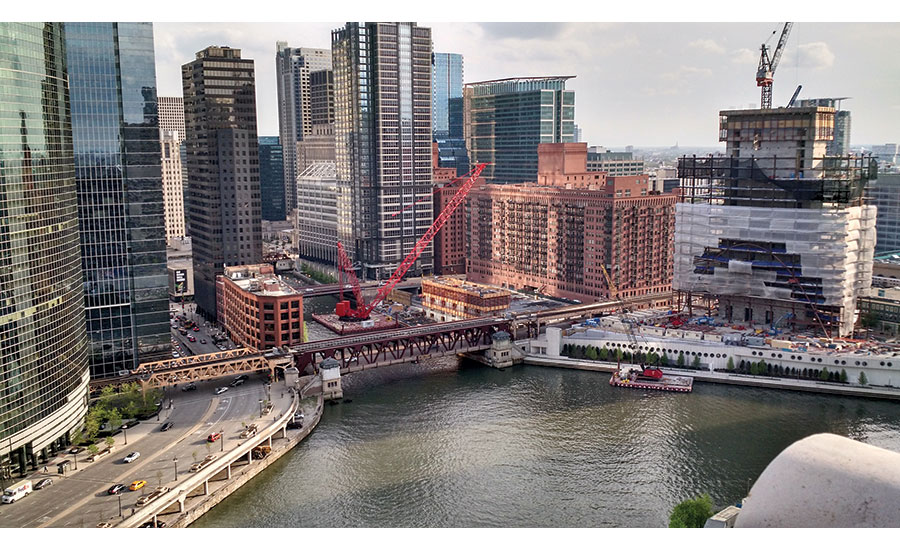Tiny Site, Big Challenges At 150 North Riverside
Innovative 55-story tower, calling for barge-mounted equipment and materials, takes shape on long vacant Chicago riverfront property

Growing Pains For decades, a small lot squeezed alongside the Chicago River sat vacant. Ironically, the river ultimately proved part of the solution for developing 150 North Riverside. Photos Courtesy of Goettsch Partners

On Track Work shoehorned next to Amtrak rail lines turned a small site into an urban builder’s dream. The result is a long, narrow tower with an unusually slender, 19.3:1 aspect ratio (ENR 12/15/2014 p. 12). Photos Courtesy of Goettsch Partners

‘Reverse Tied Arch’ To fit the base onto the property, a transfer truss slopes the columns in over four lower floors. Photos Courtesy of Goettsch Partners

Standing Tall Sloping the office tower on both sides gives the building an added elegance. Photos Courtesy of Goettsch Partners

On the Water Upon completion, 150 North Riverside will provide a new section to Chicago’s celebrated Riverwalk. Photos Courtesy of Goettsch Partners





Despite its marquee riverfront location in Chicago’s West Loop, a sliver of land today known as 150 North Riverside sat vacant for decades, effectively orphaned. Wedged between the Chicago River to the east and active Amtrak rail lines to the west, bookended by Lake and Randolph streets to the north and south, the lot was absent both utilities and footprint, expanding out to only 85 ft at maximum broadness. Over the years, there were plans, but to no avail.
Thanks to a number of design innovations, construction firsts and dogged collaborations, “that little sliver of land has become the greatest working site in Chicago,” says Robert Chmielowski, principal with structural engineer Magnusson Klemencic Associates (MKA).
The result will be a 55-story office tower “we now call a building in a park,” adds Joachim Schuessler of architect Goettsch Partners. “It is a 1.5-acre site and only 25% is enclosed. Everything else is open to the public pretty much, which is I think unprecedented.”
The site owner, Riverside Investment & Development Co. of Chicago, acquired the air rights above the adjacent Amtrak tracks, facilitating the construction of an overbuild that will eventually house a hidden parking level topped by a green plaza. In the meantime, the overbuild has been serving as a surface-level staging area that has allowed general contractor Clark Construction and its various subcontractors to maximize the site and efficiently move the job along. Tower construction began in 2015, and the topping-off party was held in the past few weeks. The owner will turn over the space for tenant construction in August 2016, and the building will officially open in January 2017.
According to Tony Scacco, executive vice president at Riverside Investment, members of the development and consulting team had over the previous 15 years built about 4 million sq ft of new development office space in Chicago, spread over three buildings. “None of those prior buildings had exceeded 80% leasing at opening,” he says, “and here we were at 80% leasing a year from opening.”
Pent-up demand is part of the reason, he believes, but so too is the use of novel and innovative technology and infrastructure in the $500-million project. “We expect to be upward of 90% leased at opening, which would be far and away the most successful leasing process that we’ve ever had.”
Site Constraints
Located near the confluence of the branches of the Chicago River, 150 North Riverside differentiates itself from previous site suggestions that included tucking a building down around the Amtrak lines. The tower under construction rather funnels down to land entirely on the owned footprint, utilizing the air rights over the tracks to the west for building overhang as well as the plaza.
“The base is one of the key design features of this project, and it’s all driven by the site constraints. If you were to try to drop the structure for the floor plate down onto the ground, you’d land right on the Amtrak, which was not part of the deal,” says Chmielowski. “The solution we put forth was to create a transfer truss over four stories and slope the columns in, and we elected to do it on both sides so that we were even. The big structural move here is basically a tied arch that’s been turned on its head.” The resulting overhang on the east side is similar, absent the lobby, but with open access to the river as a key part of Chicago’s ongoing Riverwalk development. “If we sloped the columns in on one side only,” he says, “we would have to deal with the fact we would have an imbalance, which is doable, but not as elegant from a structural standpoint.”
The notched corners of the floor plate are not the result of “architect gamesmanship,” says Chmielowski, “but it’s really in response to the site constraints.” The tower structure kisses the property line at various spots, “fitting like a perfect suit,” Schuessler explains. There has been a friendly debate among project team members about which corner of the building offers the best view of the city.
“We were aware of a lot of the challenges that site posed and how to overcome them,” says Chris Phares, project executive with Clark Construction. As part of a joint venture with McHugh Construction, Phares and the Clark team had worked with MKA on the River Point project on the other side of Lake Street, where an Amtrak overbuild was also part of the solution.
At 150 North Riverside, “the postage stamp suddenly became the greatest working site in the city of Chicago. In a span of weeks, it went from the worst to the best,” says Chmielowski, overlooking the busy two-acre site now without a rail line in sight.
“Currently, and for the past year, we have had one of the most desirable construction sites in any urban setting,” concurs Phares. “We went from having nothing to having a lot, and then we’ll have to start to take it away from ourselves to actually finish the project at the end of the year.”
Chmielowski gives credit to Phares and the Clark team, “which had to sequence the work in a particular fashion that is not as you might imagine. They probably would have preferred to build this whole precast overbuild structure at one time, but that would mean that the lobby glass wall couldn’t start until the garage was done. And they’re not ready to give this space up yet for staging and phasing.”
The biggest sequencing component, Phares adds, was the tower’s luxurious Goettsch-designed lobby, which features an 85-ft-tall glass wall hung from the tip of the transfer truss at Level 8.
“The tower and plaza construction needed to meet at such a point in time that the structure of the tower didn’t get in the way of the big Manitowoc 888 Ringer crane on the river” doing its job of reaching over the tower site and setting the precast over the tracks, says Phares. “We have run two independent schedule paths from one project to get both of those aspects done and meet at about the same point of time.”
The Right Opportunity
When with a previous firm, members of the development team introduced MKA to the Chicago market with the tricky 111 South Wacker tower project, calling on MKA’s background with the Rainier Tower project in its hometown of Seattle. The original plan for 111 South Wacker called for a similar structural solution as Rainier Tower, specifically a narrow footprint at the base of the building tapering out to a traditional office floor plate above. At 150 North Riverside, the fully leasable space will encompass Floors 8 to 52, totaling about 1.3 million sq ft of office space.
“Why were we the ones finally able to get 150 North Riverside going?” Scacco asks. “There was a priori knowledge of a very specialized type of building construction methodology … and it just so happened that this a priori knowledge was for a design and construction approach that exactly solved our site-specific constraints.”
Due to the narrowness of the 150 North Riverside lot, lease depth requirements forced a reduction in the number of elevators per bank from the four or five normally found in Chicago’s tall office towers. “But,” says Chmielowski, “what we had going for us was the fact that, because we could only get three elevators across, the elevators had to be arranged in a long bar configuration. So, we had not a very deep core, but a really long core.”
To meet drift and acceleration standards, MKA introduced tuned mass dampers at the top of the building, which will house some 200,000 gallons of water in 12 concrete tanks stacked in two layers of six.
“As the building drifts over, the water in the tank has inertia and wants to stay in one place and it creates a balancing liquid force against the building. As the building moves one way, the water stays and pushes up against the opposing wall and helps push the building back,” Chmielowski explains. “To our knowledge, the fact that we are using the tanks to manage drift is the first time that this has been done in the world. Tanks have been used to manage accelerations numerous times, but to manage drifts such that the cladding joints don’t get overstressed due to the story drift is a first.”
Additionally, the tanks serve “an interesting dual purpose,” says Clark’s Phares. “It’s dampening the translation of the building at the top, but we’re also using it as fire protection water, which the city of Chicago was acceptable to.”
Phares commends Wisconsin fabricator Zalk Josephs for not only bringing in some of the world’s highest-strength steel from ArcelorMittal in Luxembourg, including 70 ksi materials used for the first time in the U.S., but for “being instrumental in coming up with a constructible and cost-efficient structural design. Collectively, we took a lot of stabs at what made the most sense from a cost, constructibility and time perspective,” he says, “and we settled on what I want to call an ‘erector set’ approach.”
Chmielowski says the fabricator’s prefitting of the steel in the shop provided him a huge sigh of relief over the transfer truss. “When it came out to the field, everything fit up perfectly. One of my big messages to the contractor was, ‘We’ve got to get this right the first time, because I’m not sure I have a good way to fix this out in the field if things don’t fit up.’ There isn’t a weld out there that will fix any problems with this fit-up,” he says. “It bore fruit in the sense that every single bolt hole aligned. They had no welding and no reaming of bolt holes on the entire transfer system, which is rather incredible when you think about it.”
The use of W36x925, the largest wide-flange section in the world, “is just like an ultimate coincidence,” says Chmielowski. “In order for us to get the necessary strength and stiffness in this member, we had to go use the largest rolled shape produced in the world today.”
Teamwork Pays Off
Clark’s Phares says the solution to a complex project is the answer to a rather simple question: “Does it make sense?” To that point, he welcomes all stakeholders to the table, additionally noting the input of employees of Chicago Steel and Goebel Forming on the 150 North Riverside project.
“It was a multilayered and arduous process of planning,” says developer Scacco. “I make light of it all the time. We had a lot less stress on the execution side of this project than we did on the planning side. It was just a nuanced and complicated site to try to approach, but we had a lot of talented people in the room.”
It’s all music to Chmielowski’s ears. “That’s how we like to operate. Our most favorite jobs are the jobs where we are working with the contractors, finding opportunities, finding ways to skin the cat a little differently,” he says.
With no major field fixes or rework, Scacco figures 99% of plans have come out at or beyond expectations. “We’ve been extraordinarily surprised, pleasantly so, with the smoothness by which the work has been executed.”










